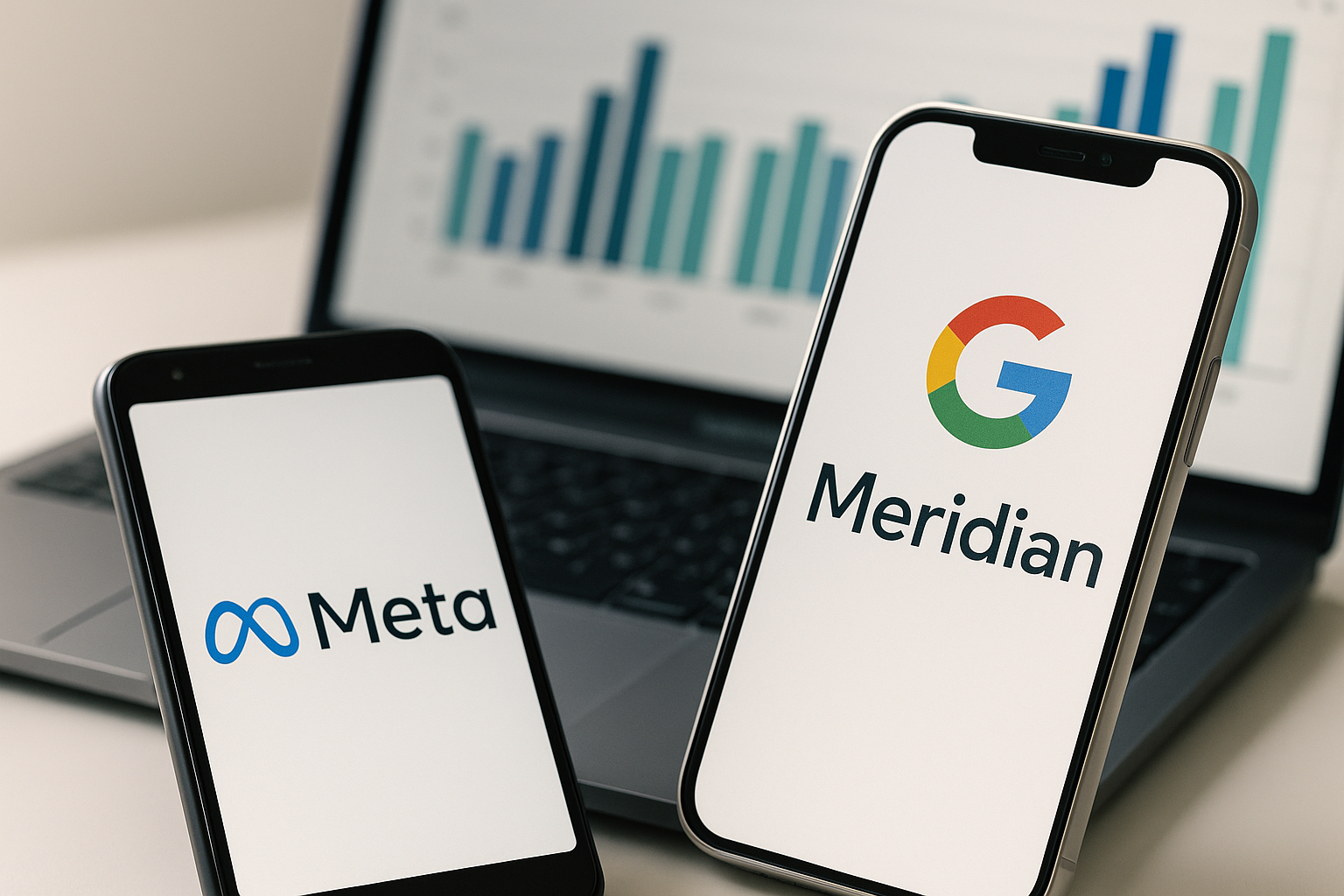Marketing tips, news and more
Explore expert-backed articles on SEO, data, AI, and performance marketing. From strategic trends to hands-on tips, our blog delivers everything you need to grow smarter.

How to Segment Your Audience in Google Ads and Meta Campaigns for Report Card Day Promotions
How to Segment Your Audience in Google Ads and Meta Campaigns for Report Card Day PromotionsReport Card Day is one of the most motivating days of the year—especially for children and teens—but it also represents a prime promotional window as families look to reward academic achievement. This period offers strong potential across categories such as toys, electronics, books, educational materials, and fashion. However, relying solely on discounts is not enough. Proper audience segmentation is one of the most critical steps to amplify the impact of your Report Card Day campaigns.In this article, we’ll walk through step-by-step how to apply strategic segmentation in Google Ads and Meta campaigns to make your promotions more efficient and drive better results.1. Focus on the Decision-Making ParentsAlthough children appear to be the end users, parents are the ones making the purchase decisions. Your ad messaging should address their needs and insights, and forge an emotional connection. Parents aged 30–50 Users interested in family-focused content CRM segments with past purchases of children’s and teen products Strategic Insight: In Google Ads, build custom intent audiences around search terms like “report card gift,” “what to get my child,” “Report Card Day deals,” “back-to-school shopping,” “kids gift ideas,” and “report card gift ideas.” On Meta, use targeting options such as “Parents with Preteens” and “Recent Purchasers in Children’s Apparel.” Also retarget existing CRM audiences who have purchased children’s products in the past.2. Segment by Digital Behavior and MotivationBuying decisions during Report Card Day stem from distinct emotional and practical motivations. Structure your segments not only by product category but also by digital behavior: Academic Rewarders: Interested in educational kits, books, and online courses. Hobby-Driven Buyers: Select gifts aligned to the child’s hobbies (art, music, STEM toys). Gaming Enthusiast Parents: Research gaming accessories and headphones. Deal Hunters: Shop early and track promotions. Strategic Insight: On Meta, serve “sales & discounts” creative to price-sensitive audiences; use narrative video ads to connect emotionally. In Google Ads, create custom intent audiences from high-intent queries like “report card gift ideas” and “reward for kid.” Expand reach by targeting users who watch “report card gift ideas” videos on YouTube.3. Optimize Product-to-Audience MatchingRelevance between product and audience profile drives conversions. Be explicit about why you’re recommending each item: Product Category Target Audience Profile Toys & Playsets Parents of children aged 6–12 Electronics & Accessories Parents of teens looking for motivation gifts Educational Materials Families with high-achieving students Fashion & Stationery Those seeking a blend of gift and practical supplies Strategic Insight: Tag your product feed with collections such as “Report Card Specials,” “Reward for Success,” and “Our Picks for Kids.” Create dedicated Shopping campaigns for each collection in Google Ads. On Meta, set up separate catalog ad sets. Since most queries are non-branded, support these collections with long-tail SEO and SEA terms like “what to get for report card day.”4. Accelerate Timing with Returning AudiencesAlthough campaign volume peaks during the final week before school ends, decision journeys start earlier. Use historical data to engage users in advance: Users who engaged with past Report Card Day campaigns Users who interacted with children’s/teen products in the last 90 days Users who purchased from gift categories a year ago but haven’t returned Strategic Insight: In Google Ads, pair your RLSA lists with seasonal keywords like “report card gift.” On Meta, target past purchasers with dynamic product ads. Use CRM-enabled email and push campaigns offering early access, guaranteed delivery, or exclusive perks to capture interest ahead of the main rush.Conclusion Centering on the parents who make the purchase decisions amplifies your campaign’s emotional impact. Behavior-based segmentation enables more contextually relevant, conversion-driven messaging. Optimizing product-to-audience matches increases campaign ROI. Strategically using historical data lowers costs and boosts loyalty. Remember: Report Card Day campaigns aren’t just about the students—they’re about the parents who want to celebrate their children’s achievements. Reaching the right person, at the right time, with the right message, is the key to turning your brand into a memorable experience.

Automating RFM-Based Audience Segmentation for E-Commerce Brands Using Google Cloud
Hello

Optimize Your Apple Search Ads Campaigns with Strategic Structures
Optimize Your Apple Search Ads Campaigns with Strategic StructuresApple Search Ads is now available in Turkey and more than 20 countries!Apple Search Ads appears in: Today Tab Search Tab Search Results Product Pages Flexible budget management and performance-oriented optimisation opportunities await you with Advanced and Basic options.According to Apple data: 95% of those who click on the advert download the application within 1 minute. Ads provide 2 times more impressions than organic results. Conversion rate over 60% is achieved. Strategic Structures are Essential for Successful CampaignsSuccess in Apple Search Ads starts with a strong strategic structure. Proper campaign organization not only optimizes performance but also accelerates growth and provides valuable insights. In this guide, we’ll walk you through step-by-step strategies to optimize your campaigns effectively.1. Keep Campaign Elements OrganizedEffective campaign management begins with a clear structure: Budget and Target Regions: Set your budget and select your target markets at the campaign level. Ad Groups: Optimize keyword selection, bidding strategies, and ad variations. 2. Segment Keywords by ThemesOrganize your campaigns into four main themes to maximize efficiency: Brand Campaigns: Target keywords related to your company or app name. Category Campaigns: Focus on non-branded keywords that describe your app’s category or functionality. Competitor Campaigns: Target keywords related to competitor brands. Discovery Campaigns: Use Broad Match and Search Match to uncover new keyword opportunities. Pro Tips: Exact Match: Use exact match in Brand, Category, and Competitor campaigns; disable Search Match. Negative Keywords: Use in Discovery campaigns to avoid overlap and improve focus. 3. Gather Insights from Discovery CampaignsAnalyze performance data from Discovery campaigns to: Add high-performing keywords to other campaigns. Exclude low-performing terms to optimize ad spend. 4. Customize Campaigns by RegionFor larger markets or regions with distinct goals, tailor your campaigns: Dedicated Campaigns: Create separate campaigns for specific countries or regions. Regional Grouping: Group similar regions together for simplified management. ConclusionA planned campaign structure is a critical step to achieve success in Apple Search Ads. You can optimise your campaigns with keyword segmentation, insights from discovery campaigns and regional customisations.

Effective Marketing during Ramadan: Strengthen Your Strategy with Insights and Trends
Effective Marketing during Ramadan: Strengthen Your Strategy with Insights and TrendsRamadan continues to be a period of significant changes in consumer behaviour. As daily lifestyles change, people's consumption habits evolve, but the underlying needs and motivations remain largely the same. By understanding these underlying needs and motivations, as well as the consumer's consumption journey, and developing marketing strategies specific to Ramadan, brands can successfully navigate one of the highest volume and most profitable periods of the year.First of all, we will examine how Ramadan consumer behaviour changes and category-based trends, and then we will take a detailed look at how we can shape marketing strategies during this period in the light of these insights and trends.Source: Google Ramadan Insights 2025How Does Consumer Behavior Change During Ramadan?Ramadan brings significant shifts in shopping habits and digital content consumption. According to Google Insights 2025, interest in Ramadan begins earlier each year. This highlights the importance of focusing not only on Ramadan itself but also on the Pre-Ramadan period.Key Areas of Interest Before Ramadan Increased searches related to home cleaning, kitchenware, and food stocking. A surge in interest in Ramadan packages, special recipes, and table decorations. Rising Mobile Usage and Content Consumption Screen time on mobile devices increases significantly. YouTube sees a more than 50% rise in views for cooking tutorials, series, and movies. Users spend more time on mobile devices, particularly during suhoor and iftar hours. Short-form video consumption reaches record levels. Category-Based Changes in Consumer Behavior Food and recipe searches peak in the first weeks of Ramadan. Interest in kitchenware and small home appliances rises. Skincare products experience the highest click-through rates of the year. Towards the end of Ramadan, fashion and footwear shopping spikes to levels comparable to Black Friday. How to Strengthen Your Marketing Strategy During RamadanPlan Your Campaigns and Promotions in AdvanceConsumers start shopping 2–3 weeks before Ramadan, making it essential for brands to: Launch early campaigns to be part of the decision-making process. Offer flexible payment options and special discounts to encourage conversions. Develop Ramadan-specific product bundles and promotional campaigns to stand out. Optimize Advertising Strategies for the Right Times and ChannelsSince mobile usage peaks during suhoor and iftar, brands should: Schedule advertising campaigns around these peak hours. Use Reminder Ads to keep promotions top-of-mind for consumers. Leverage specialized solutions like YouTube Select Ramadan Line-Up and TikTok Pulse Ramadan Category to target highly relevant audiences. Create engaging and interactive campaigns on TikTok, where 81% of users try new things inspired by Ramadan-related content. Enhance Your Video and Content StrategyThroughout Ramadan, consumers engage with: Cooking tutorials, personal vlogs, and content focused on spirituality and self-improvement. Influencer collaborations that help brands reach a broader audience. Short-form videos (YouTube Shorts, Instagram Reels) that drive dynamic engagement. Focus on Eid Shopping Sales of clothing, footwear, and gift items surge before Eid. Email and SMS marketing strategies can be used for timely reminders. Ramadan offers unique opportunities for brands to establish deep and meaningful connections with consumers. During this period, brands that correctly analyse changes in consumer behaviour and shape their strategies with these insights can stand out from the competition and create a loyal customer base.By adopting innovative and data-driven approaches during Ramadan, you can ensure that your brand builds stronger bonds with consumers and develops strategies in the spirit of this holy month.

Google Meridian MMM & Facebook (Meta) Robyn MMM: In-depth Analysis of Modern Marketing Modeling Tools
In today’s marketing landscape, data-driven decision-making is a key factor in strategic success. Marketing Mix Modeling (MMM) is a crucial analysis technique that helps measure the impact of advertising expenditures on sales and other key performance indicators (KPIs). Traditionally, MMM was accessible only to large corporations with significant budgets, but thanks to open-source solutions, it has become available to businesses of all sizes.Google’s Meridian MMM and Meta’s Robyn MMM represent two advanced approaches to modern MMM. This article provides an in-depth comparison of these tools, examining their methodologies, use cases, advantages, and limitations.What is Marketing Mix Modeling (MMM)?MMM is a statistical regression technique that helps businesses understand how marketing activities influence sales, conversions, and traffic over time.Its core functions include: ✔ Measuring the impact of advertising spend, promotions, seasonality, and economic factors on sales. ✔ Modeling adstock (delayed effects) and saturation (diminishing returns) to better reflect long-term marketing impact. ✔ Providing predictive insights for budget allocation and strategic planning. Google Meridian MMM and Meta Robyn MMM offer different approaches to tackling these challenges.Google Meridian MMM: In-Depth ReviewKey Features & MethodologyLaunched by Google in 2024 as an open-source project on GitHub, Meridian MMM introduces a Bayesian regression approach, making it highly flexible in handling uncertainty and incomplete data.Key features include: ✔ Bayesian Regression: Provides probability distributions rather than fixed estimates, improving robustness with limited data. ✔ Adstock & Saturation Modeling: Captures how marketing spend accumulates over time and reaches diminishing returns. ✔ Geo-Level Analysis: Incorporates regional marketing data to evaluate local trends. ✔ Google Data Integration: Direct access to Google Search volume and YouTube reach data for more precise insights in digital advertising. Use Cases & AdvantagesMeridian is ideal for companies with strong in-house data science teams and those investing heavily in the Google ecosystem: ✔ Optimized for Google Ads & YouTube campaigns – making it particularly useful for brands reliant on these channels. ✔ Geo-specific modeling capabilities, helping businesses assess performance in different markets. ✔ Supports measurement-driven marketing cultures, where ROI and incrementality testing play a central role. Limitations & Challenges ❌ High technical requirements: Requires expertise in data engineering and advanced statistical modeling. ❌ Executive-level communication challenges: Outputs can be complex, making it harder to generate clear business insights for non-technical stakeholders. ❌ Documentation & adoption hurdles: Being a new solution, documentation and user guides are still evolving. Facebook (Meta) Robyn MMM: In-Depth ReviewKey Features & MethodologyMeta’s Robyn MMM modernizes MMM by incorporating advanced data science techniques while maintaining accessibility for a wider audience.Key features include: ✔ Prophet Integration: Automatically detects seasonality, trends, and holiday effects for more accurate forecasts. ✔ Ridge Regression: Reduces overfitting and improves generalizability. ✔ Hyperparameter Optimization: Uses Nevergrad for continuous model fine-tuning and performance enhancement. ✔ Adstock & Saturation Effects: Models how media spend drives sales over time and when additional spending loses efficiency. Use Cases & AdvantagesRobyn is particularly valuable for businesses looking to implement MMM with limited budgets: ✔ Open-source accessibility makes it an attractive choice for small and medium-sized businesses. ✔ Real-time optimization capabilities allow dynamic adjustments to marketing campaigns. ✔ Advanced visualization tools generate clear, easy-to-understand reports for marketing teams. Limitations & Challenges ❌ Technical complexity: Requires proficiency in R programming, making implementation more challenging for non-technical users. ❌ Fixed media coefficients: Certain seasonality and campaign-based fluctuations may not be captured accurately. ❌ Limited documentation for advanced customization: Features like calibration and priors lack detailed examples, making full utilization difficult. The Future of MMM StrategiesBoth Google Meridian MMM and Facebook (Meta) Robyn MMM offer advanced solutions for measuring marketing effectiveness and optimizing media budgets. Meridian leverages Bayesian approaches and Google’s proprietary data sources to provide deep insights into digital campaigns, while Robyn offers a more flexible, real-time optimization framework through Prophet and Ridge regression.The choice between these tools depends on factors such as data availability, marketing budget, and internal technical expertise. As machine learning and AI-driven modeling continue to evolve, both tools are expected to become even more sophisticated, making marketing strategies more dynamic and data-driven.

Proactive SEO: Reporting and Analysis with Screaming Frog Scheduling
Manually conducted technical SEO audits, especially for large-scale websites, often turn into repetitive and time-consuming processes that can take hours or even days. Spending this valuable time on data gathering instead of analysis and strategy development decreases overall efficiency. At this point, automation becomes one of modern SEO’s strongest allies, enabling a shift toward proactive site health management. It helps you discover which pages to prioritize.This is where Screaming Frog's scheduling feature steps in as a true lifesaver—allowing you to replace exhausting manual audits with an automated system that keeps track of your website’s technical health 24/7.What is Screaming Frog Scheduling and Why is it a Game-Changer?Screaming Frog Scheduling is a feature available in the paid version of the SEO Spider tool that allows you to automatically run pre-configured crawl settings at your specified times and frequencies. In short, even if you're not at your computer, Screaming Frog can crawl your website on your behalf.The core purpose of this feature is to automate repetitive auditing tasks, eliminate human error, standardize processes, and give you back your most valuable resource—time.- First, it eliminates the weekly hours spent on manual crawls, giving you extra time for strategy development and data analysis.- Second, since each crawl is run with the same saved configuration file, your data is 100% consistent. This makes it easy to track changes over time (such as increasing 404 errors or broken redirect chains).- Finally, and most critically, it provides real-time detection—allowing you to prevent a potential organic traffic disaster before it even begins.Step-by-Step Guide to Setting Up Scheduled CrawlsStep 1: Save Your Crawl Configuration Template:Start by saving the settings of the crawl you want to automate. Configure crawl settings such as the crawl mode, tags and links to be included, crawl depth, and elements to exclude.Step 2: Integrate Google Analytics 4 and Google Search Console APIs:Under Configuration > API Access, integrate Google Analytics 4 and Google Search Console to enrich crawl data with real-time Google performance metrics tied to each URL.Once done, save this configuration via File > Configuration > Save As into a .seospiderconfig file. This file will serve as the blueprint for all future automated crawls.Step 3: Create a Scheduled Task:Under File > Scheduling, click the Add button to create a new task. Use the Date/Time field to set how frequently the crawl should run—options include Daily, Weekly, and Monthly.Step 4: Choose the Crawl Mode:You can opt for Standard or List Mode. In List Mode, you can crawl a specific list of URLs using a locally stored .xlsx file.Step 5: Define the Output Location:Decide where the crawl output should be saved—either locally or to your connected Google Drive account.Step 6: Export to Google Drive or Google Sheets:To export reports directly to Google Drive or Sheets, simply link your Google account under the Google Drive Account menu.Step 7: Select Reports and Export Settings:In the Reports and Exports tabs, select which predefined reports (e.g., Redirects, Title Errors, etc.) should be automatically generated and saved after each crawl.Step 8: Choose Export Format:Specify the format in which you want the data to be saved (e.g., CSV, XLSX).Optional: Integrate with Looker Studio to visualize and analyze your exports more interactively.Data Enrichment: Google Search Console & GA4 API IntegrationThe technical insights Screaming Frog provides (URL structure, HTTP status codes, meta tags, etc.) are extremely valuable, but they only tell half the story. The other half is how users interact with those pages and how Google evaluates them in SERPs.That’s where Google Search Console (GSC) and Google Analytics 4 (GA4) API integration becomes crucial. This integration merges technical data with performance and behavioral metrics—empowering you to move from basic queries like:“Which pages have titles over 60 characters?” to “Which pages have high impressions, low CTR, and also a poor Largest Contentful Paint (LCP) score?”To enable this, API authorization must be completed for the relevant sources in Screaming Frog. Once integrated and configured, save your settings as a .seospiderconfig file or upload it to your Drive account.When you assign this configuration to your scheduled task, Screaming Frog will fetch real-time data—clicks, impressions, CTR, average position, users, sessions, conversions, etc.—from GSC and GA4 for each crawl. This allows you to prioritize technical SEO tasks based on actual business impact.Automated Reporting: Advanced Export SettingsScreaming Frog’s scheduling feature lets you fully automate your reporting process. Instead of dealing with dozens of export files after every crawl, you can predefine which specific reports should be automatically created.For example, for a weekly “Health Crawling Check,” you might only export:- 4xx Error Pages- Redirect Chains- Canonical Issues- Non-Indexable PagesAnalyticaHouse Pro-Tip: Practical Use Cases for Scheduled CrawlsThe key to maximizing the benefits of scheduled crawls is to apply them in the right scenarios. At AnalyticaHouse, we frequently use scheduled crawls for:Weekly Crawling CheckMonitor critical SEO issues weekly:- 5xx Server Errors- New 4xx Pages- Indexability Issues: Detect mistakenly noindexed or robots.txt-blocked pages- Canonical Tag Errors: Identify duplicate content issues due to incorrect canonicalizationCompetitor AnalysisSet up weekly or monthly crawls of competitors to automatically monitor their strategic moves:- Changes in site architecture or URL hierarchy- New meta titles and descriptions reflecting targeted keywords- Newly added content sections or blog posts- Implementation of new structured data types (Schema)Post-Migration ChecksAfter a site migration, it’s vital to ensure that 301 redirects from old to new URLs work correctly. Manually checking thousands of URLs is unrealistic.Instead, schedule a List Mode crawl using a list of old URLs. This ensures every legacy URL redirects properly. If a redirect breaks (e.g., leads to a 404), you'll be alerted immediately.Centralizing All SEO Data in Google BigQueryThe main objective here is to build a scalable and queryable data warehouse that combines data from Screaming Frog, GA4, and GSC. This allows you to build fully automated, detailed, and customizable reports using tools like Looker Studio or Google Sheets.Key Components:- Schedule Timing: Customize frequency and timing of crawls- GA4 & GSC Integration: Real-time Google metrics per URL- BigQuery & URL Breakdown: Store and categorize URLs by path type (e.g., /blog, /category, /product)- Metric Selection: Choose which performance metrics to pull (e.g., GA4 Sessions, Purchases, Revenue, Conversion Rate; GSC Impressions, Clicks, CTR, Average Position)- Functional Reporting: Upload bulk URL lists to monitor their performance over time- Looker Studio & Sheets Integration: Use the BigQuery table to create interactive dashboards and automated reports updated in real time

